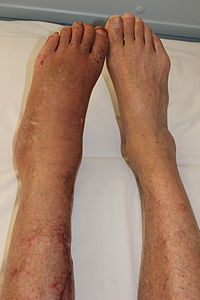
Photo from wikipedia
Hung et al. [1] conducted a clinically relevant meta-analysis investigating the advantages of intraoperative ketamine administration on postoperative pain scores and opioid consumption after bariatric surgery. The authors included nine… Click to show full abstract
Hung et al. [1] conducted a clinically relevant meta-analysis investigating the advantages of intraoperative ketamine administration on postoperative pain scores and opioid consumption after bariatric surgery. The authors included nine randomized controlled trials and showed a reduction in postoperative morphine consumption within the first 6 h and lower pain scores in the first hour after surgery in the group of patients treated with ketamine. Conversely, there were no significant differences on opioid consumption and pain scores in the late postoperative period, which was selected as primary endpoint by the authors. In the context of these results, we think it is of utmost importance to establish the robustness of the above findings, thereby investigating the need for further research. Therefore, the manuscript would highly benefit from trialsequential analyses (TSAs) exploring such robustness. In order to provide such information, we used the TSA Software (Copenhagen Trial Unit’s TSA Software®; Copenhagen, Denmark), and the “information size” was computed assuming an alpha risk of 5% with a power of 80%. We used a random effect model, and the estimated outcome effects on opioid consumption were computed assuming a mean difference of 5 and 10 mg of morphine within 6 h and at 16–24 h, respectively; similarly, we assumed a mean difference of 1 and 0.5 points on pain scores at 1 h and at 12–24 h, respectively. Further details on TSA and its interpretation are available elsewhere [2, 3]. Therefore, we conducted a total of four TSAs on the effects of ketamine in patients undergoing bariatric surgery: the first two focused on results in the initial postoperative hours, and the latter two on pain scores and opioid consumption at longer time points. Regarding on the initial postoperative hours, the two TSAs showed robustness of the findings by Hung et al. Indeed, for opioid consumption, the Z-curve crossed the “information size” needed (n = 212/153), significantly favoring ketamine (Fig. 1a). Concerning the early pain scores, although the “information size” was not reached (n = 390/472), the Z-curve crossed the “alpha-spending boundary” (O’Brien-Fleming method), again favoring the use of ketamine. Conversely, as shown in Fig. 2, the TSAs conducted on pain scores and opioid consumption at longer time points showed that results are not robust and more research is warranted as in both cases the Z-curves did not reach the “information size” (opioid requirements within the first postoperative 24 h, n = 258/866; pain scores at 12–24 h, n = 244/398), without crossing the “futility area” or the “alpha-spending boundary.” Overall, these results suggest that ketamine could be a valid option in patients undergoing bariatric surgery. Indeed among other valuable strategies [4–9], ketamine could contribute to the reduction in postoperative opioids consumption and in limiting postoperative and chronic hyperalgesia [10]. Its analgesic effects in the early postoperative period seem * Luigi La Via [email protected]
Journal Title: Obesity Surgery
Year Published: 2022
Link to full text (if available)
Share on Social Media: Sign Up to like & get
recommendations!